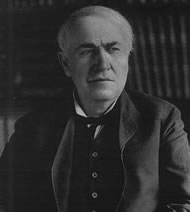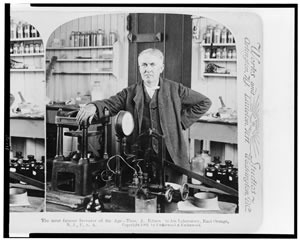Thomas Edison (1847)

Source: Wikimedia Commons (Public Domain)
Thomas Edison was born in 1847 in Milan, Ohio. Young Tom didn't do very well in school, so his mother decided to teach him at home. She gave him lots of books to read. Tom was a curious boy. He always wanted to know how things worked. He liked to see if he could make them work better. His mother let him set up a laboratory in the house where he could experiment with things.
As a young man, Tom set up a lab of his own, where he could try out his ideas. He invented lots of things in his laboratory. Guess what his favorite invention was? It was the phonograph. Before the phonograph, if you wanted to hear music, you had to play it yourself or go to a concert.
Edison's most famous invention was the light bulb. At the time, people used gas or oil lamps to light their homes. Edison knew it would be cheaper and easier to use electricity. The trouble was, nobody knew how to do it. Edison worked on his idea a long time . He tried lots of things that didn't work. But he didn't give up. He kept trying until one day it worked! Today, you can flip a switch and have light any time you want it.

Source: Underwood & Underwood, U.S. Library of Congress (Public Domain)
Edison also built the first power plant. Edison's Pearl Street Power Station opened in 1882 in New York City. It sent electricity to 85 customers and made enough power to light 5,000 lamps.
Edison also invented the movie camera. When you go to the movies or watch TV, you can thank him for his ideas and hard work. Many of the electric machines you see at home or at school came from his ideas.
Inventing things was what Edison liked best. He thought about how things worked. Then he thought about how he could do it better. That is called inspiration. The hard part came next. Edison had to make his ideas work. He tried all kinds of things until he found exactly what would work. He called that perspiration. He said that invention was "one percent inspiration and ninety-nine percent perspiration."


